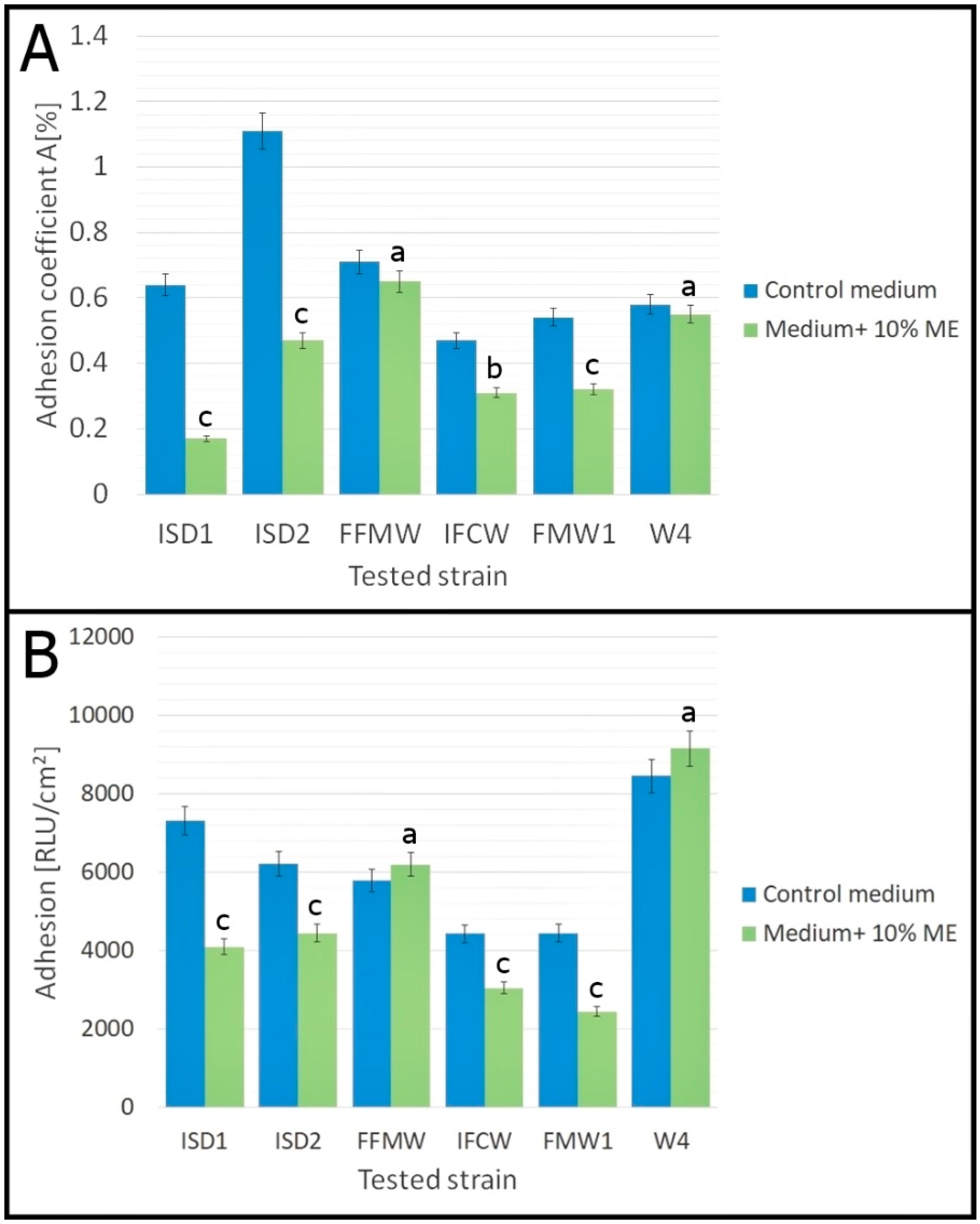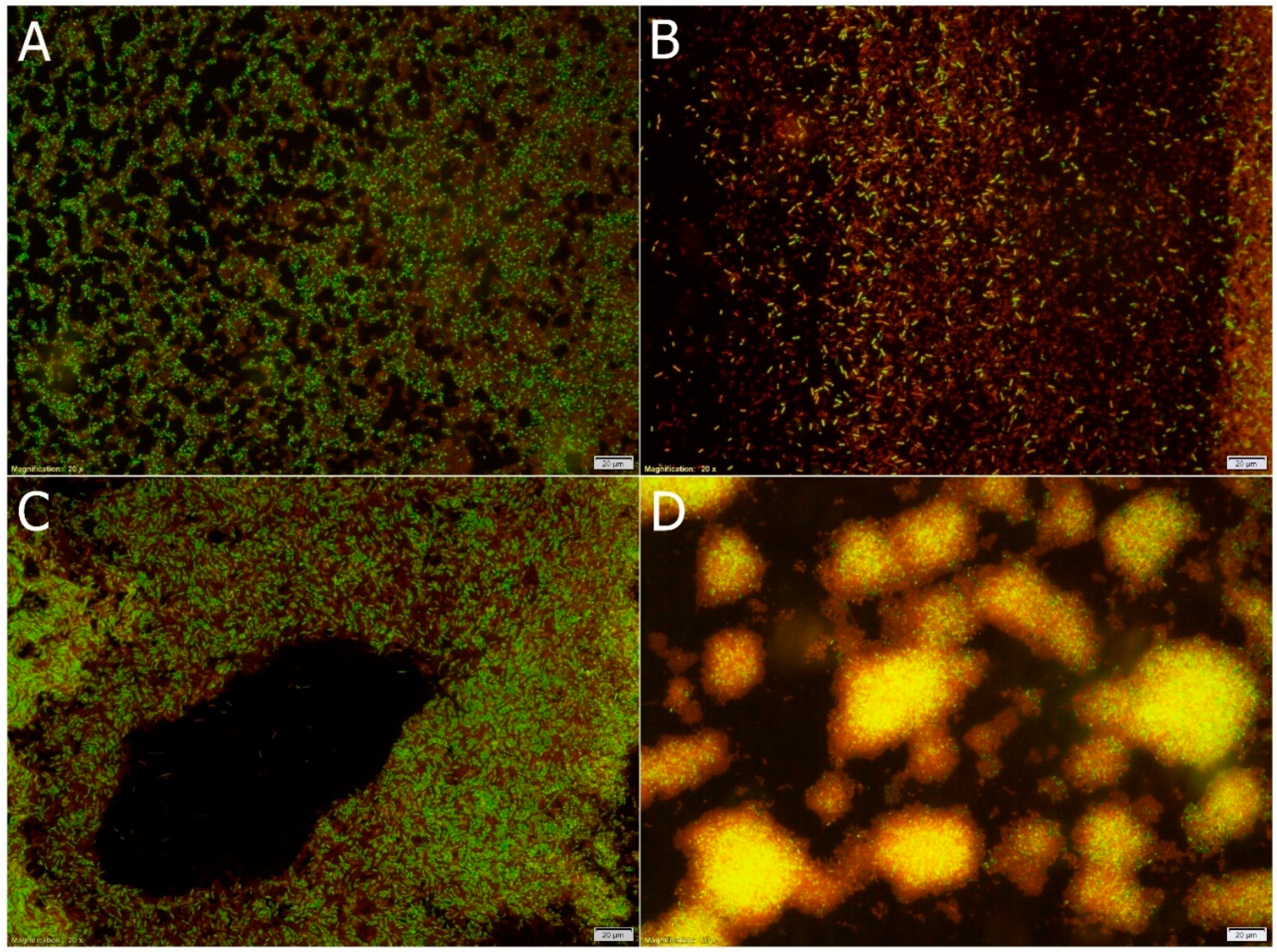Activity of Mentha piperita L. Ethanol Extract against Acetic Acid Bacteria Asaia spp.
Abstract
:1. Introduction
2. Materials and Methods
2.1. Materials
2.1.1. Plant Extract
2.1.2. Bacterial Strains
2.2. Methods
2.2.1. Antibacterial Activity of Mint Extract
2.2.2. Bacterial Adhesion
2.2.3. Fluorescence Microscopy
2.2.4. Chemical Constituents Analysis
2.2.5. Statistics
3. Results and Discussion
3.1. Antibacterial Activity
3.2. Antiadhesive Activity
3.3. Chemical Composition
4. Conclusions
Author Contributions
Funding
Conflicts of Interest
References
- Kręgiel, D. Health safety of soft drinks: Contents, containers, and microorganisms. Biomed. Res. Int. 2015, 2015, 128697. [Google Scholar] [CrossRef] [PubMed]
- Walker, M.; Phillips, C.A. The effect of preservatives on Alicyclobacillus acidoterrestris and Propionibacterium cyclohexanicum in fruit juice. Food Control 2008, 19, 974–981. [Google Scholar] [CrossRef]
- Sokołowska, B.; Skąpska, S.; Fonberg-Broczek, M.; Niezgoda, J.; Chotkiewicz, M.; Dekowska, A.; Rzoska, S.J. Factors influencing the inactivation of Alicyclobacillus acidoterrestris spores exposed to high hydrostatic pressure in apple juice. High Press. Res. 2013, 33, 73–82. [Google Scholar] [CrossRef]
- Moore, J.E.; McCalmont, M.; Xu, J.; Millar, B.C.; Heaney, N. Asaia sp., an unusual spoilage organism of fruit-flavored bottled water. Appl. Environ. Microbiol. 2002, 68, 4130–4131. [Google Scholar] [CrossRef] [PubMed]
- Sedláčková, P.; Čeřovský, M.; Horsáková, I.; Voldřich, M. Cell surface characteristic of Asaia bogorensis-spoilage microorganism of bottled water. Czech J. Food Sci. 2011, 29, 457–461. [Google Scholar] [CrossRef]
- Horsáková, I.; Voldřich, M.; Čeřovskỳ, M.; Sedláčková, P.; Šicenrová, P.; Ulbri, P. Asaia sp. as a bacterium decaying the packaged still fruit beverages. Czech J. Food Sci. 2009, 27, 362–365. [Google Scholar] [CrossRef]
- Kręgiel, D.; James, S.A.; Rygała, A.; Berłowska, J.; Antolak, H.; Pawlikowska, E. Consortia formed by yeasts and acetic acid bacteria Asaia spp. in soft drinks. Antonie Leeuwenhoek 2018, 11, 373–383. [Google Scholar] [CrossRef] [PubMed]
- Kręgiel, D.; Rygała, A.; Libudzisz, Z.; Walczak, P.; Ołtuszak-Walczak, E. Asaia lannensis—The spoilage acetic acid bacteria isolated from strawberry-flavored bottled water in Poland. Food Control 2012, 26, 147–150. [Google Scholar] [CrossRef]
- Antolak, H.; Oracz, J.; Otlewska, A.; Żyżelewicz, D.; Kręgiel, D. Identification of carotenoids and isoprenoid quinones from Asaia lannensis and Asaia bogorensis. Molecules 2017, 22, 1608. [Google Scholar] [CrossRef] [PubMed]
- Antolak, H.; Czyżowska, A.; Kręgiel, D. Black currant (Ribes nigrum L.) and bilberry (Vaccinium myrtillus L.) fruit juices inhibit adhesion of Asaia spp. Biomed. Res. Int. 2016, 2016, 3671306. [Google Scholar] [CrossRef] [PubMed]
- Kręgiel, D.; Otlewska, A.; Antolak, H. Attachment of Asaia bogorensis originating in fruit-flavored water to packaging materials. Biomed. Res. Int. 2014, 2014, 514190. [Google Scholar] [CrossRef] [PubMed]
- Kręgiel, D. Attachment of Asaia lannensis to materials commonly used in beverage industry. Food Control 2013, 32, 537–542. [Google Scholar] [CrossRef]
- Antolak, H.; Kręgiel, D.; Czyżowska, A. Adhesion of Asaia bogorensis to glass and polystyrene in the presence of cranberry juice. J. Food Prot. 2015, 78, 1186–1190. [Google Scholar] [CrossRef] [PubMed]
- Antolak, H.; Czyżowska, A.; Sakač, M.; Mišan, A.; Đuragić, O.; Kręgiel, D. Phenolic compounds contained in little-known wild fruits as antiadhesive agents against the beverage-spoiling bacteria Asaia spp. Molecules 2017, 22, 1256. [Google Scholar] [CrossRef] [PubMed]
- Salehi, B.; Stojanović-Radić, Z.; Matejić, J.; Sharopov, F.; Antolak, H.; Kręgiel, D.; Sen, S.; Sharifi-Rad, M.; Acharya, K.; Sharifi-Rad, R.; et al. Plants of genus Mentha: From farm to food factory. Plants 2018, 7, 70. [Google Scholar] [CrossRef] [PubMed]
- Antolak, H.; Czyżowska, A.; Kręgiel, D. Antibacterial and antiadhesive activities of extracts from edible plants against soft drink spoilage by Asaia spp. J. Food Prot. 2017, 80, 25–34. [Google Scholar] [CrossRef] [PubMed]
- Sujana, P.; Sridhar, T.M.; Josthna, P.; Naidu, C.V. Antibacterial activity and phytochemical analysis of Mentha piperita L. (peppermint)—An important multipurpose medicinal plant. Am. J. Plant Sci. 2013, 4, 77–83. [Google Scholar] [CrossRef]
- Bupesh, G.; Amutha, C.; Nandagopal, S.; Ganeshkumar, A.; Sureshkumar, P.; Murali, K.S. Antibacterial activity of Mentha piperita L. (peppermint) from leaf extracts‒A medicinal plant. Acta Agric. Slov. 2007, 89, 73–79. [Google Scholar] [CrossRef]
- Laggoune, S.; Öztürk, M.; Erol, E.; Duru, M.E.; Abaza, I.; Kabouche, A.; Kabouche, Z. Chemical composition, antioxidant and antibacterial activities of the essential oil of Mentha spicata L. from Algeria. J. Mater. Environ. Sci. 2016, 7, 4205–4213. [Google Scholar]
- Dhiman, R.; Aggarwal, N.; Aneja, K.R.; Kaur, M. In vitro antimicrobial activity of spices and medicinal herbs against selected microbes associated with juices. Int. J. Microbiol. 2016, 9015802. [Google Scholar] [CrossRef]
- Liu, Y.; Zhao, Q. Influence of surface energy of modified surfaces on bacterial adhesion. Biophys. Chem. 2005, 117, 39–45. [Google Scholar] [CrossRef] [PubMed]
- Kręgiel, D. Advances in biofilm control for food and beverage industry using organo-silane technology: A review. Food Control 2014, 40, 32–40. [Google Scholar] [CrossRef]
- Kręgiel, D.; Niedzielska, K. Effect of plasma processing and organosilane modifications of polyethylene on Aeromonas hydrophila biofilm formation. Biomed. Res. Int. 2014, 2014, 232514. [Google Scholar] [CrossRef] [PubMed]
- Kręgiel, D.; Berłowska, J.; Mizerska, U.; Fortuniak, W.; Chojnowski, W.; Ambroziak, W. Chemical modification of polyvinyl chloride and silicone elastomer in inhibiting adhesion of Aeromonas hydrophila. World J. Microbiol. Biotechnol. 2013, 29, 1197. [Google Scholar] [CrossRef] [PubMed]
- Kruk, T.; Szczepanowicz, K.; Kręgiel, D.; Szyk-Warszyńska, L.; Warszyński, P. Nanostructured multilayer polyelectrolyte films with silver nanoparticles as antibacterial coatings. Colloids Surf. B. Biointerfaces 2016, 137, 158–166. [Google Scholar] [CrossRef] [PubMed]
- Marcous, A.; Rasouli, S.; Ardestani, F. Low-density polyethylene films loaded by titanium dioxide and zinc oxide nanoparticles as a new active packaging system against Escherichia coli O157:H7 in fresh calf minced meat. Packag. Technol. Sci. 2017. [Google Scholar] [CrossRef]
- Antolak, H.; Mizerska, U.; Berłowska, J.; Otlewska, A.; Kręgiel, D. Quillaja saponaria saponins with potential to enhance the effectiveness of disinfection processes in the beverage industry. Appl. Sci. 2018, 8, 368. [Google Scholar] [CrossRef]
- Koziróg, A.; Kręgiel, D.; Brycki, B. Action of monomeric/gemini surfactants on free cells and biofilm of Asaia lannensis. Molecules 2017, 22, 2036. [Google Scholar] [CrossRef] [PubMed]
- De Feiria, S.N.B.; de Laet Santana, P.; Boni, G.C.; Anibal, P.C.; Boriollo, M.F.G.; Figueira, G.M.; de Oliveira Sousa, I.M.; Pereira, B.; Foglio, M.A.; Höfling, J.F. Essential oil composition of Mentha spp. extracted seasonally and their effects against Candida yeast growth and biofilm formation. Adv. Med. Plant. Res. 2016, 4, 106–129. [Google Scholar]
- Perumalla, A.V.S.; Hettiarachchy, N.S. Green tea and grape seed extracts—Potential applications in food safety and quality. Food Res. Int. 2011, 44, 827–839. [Google Scholar] [CrossRef]
- Dhifi, W.; Jelali, N.; Mnif, W.; Litaiem, M.; Hamdi, N. Chemical composition of the essential oil of Mentha spicata L. from Tunisia and its biological activities. J. Food Biochem. 2013, 37, 362–368. [Google Scholar] [CrossRef]
- Soković, M.D.; Glamočlija, J.; Marin, P.D.; Brkić, D.; van Griensven, L.J.L.D. Antibacterial effects of the essential oils of commonly consumed medicinal herbs using an in vitro model. Molecules 2010, 15, 7532–7546. [Google Scholar] [CrossRef] [PubMed]
- Shahbazi, Y. Chemical composition and in vitro antibacterial activity of Mentha spicata essential oil against common food-borne pathogenic bacteria. J. Pathog. 2015. [Google Scholar] [CrossRef] [PubMed]
- Hyldgaard, M.; Mygind, T.; Meyer, R.L. Essential oils in food preservation: Mode of action, synergies, and interactions with food matrix components. Front. Microbiol. 2012. [Google Scholar] [CrossRef] [PubMed]
- Roidaki, A.; Zoumpoulakis, P.G.; Proestos, C. Comparison of extraction methods for the determination of antioxidant activity in extracts of Hippophae rhamnoides L. and Lippia citriodora. The effect of seasonal collection. Austin J. Nutr. Food Sci. 2015, 3, 1057–1064. [Google Scholar]



| No. | Time | λmax (nm) | Proposed Molecule |
|---|---|---|---|
| 1 | 3.783 | 277 | Gallic acid |
| 2 | 11.073 | 324 | Neochlorogenic acid |
| 3 | 16.323 | 323 | Chlorogenic acid |
| 4 | 17.415 | 279 | Epicatechin |
| 5 | 20.868 | 308 | p-Coumaric acid |
| 6 | 23.787 | 322 | Ferulic acid |
| 7 | 30.947 | 290 | Rosmarinic acid |
| 8 | 32.133 | 318 | Quercetin-3-rutinoside |
| 9 | 33.993 | 322 | Caffeic acid derivative |
| 10 | 54.065 | 318 | Quercetin |
© 2018 by the authors. Licensee MDPI, Basel, Switzerland. This article is an open access article distributed under the terms and conditions of the Creative Commons Attribution (CC BY) license (http://creativecommons.org/licenses/by/4.0/).
Share and Cite
Antolak, H.; Czyżowska, A.; Kręgiel, D. Activity of Mentha piperita L. Ethanol Extract against Acetic Acid Bacteria Asaia spp. Foods 2018, 7, 171. https://doi.org/10.3390/foods7100171
Antolak H, Czyżowska A, Kręgiel D. Activity of Mentha piperita L. Ethanol Extract against Acetic Acid Bacteria Asaia spp. Foods. 2018; 7(10):171. https://doi.org/10.3390/foods7100171
Chicago/Turabian StyleAntolak, Hubert, Agata Czyżowska, and Dorota Kręgiel. 2018. "Activity of Mentha piperita L. Ethanol Extract against Acetic Acid Bacteria Asaia spp." Foods 7, no. 10: 171. https://doi.org/10.3390/foods7100171
APA StyleAntolak, H., Czyżowska, A., & Kręgiel, D. (2018). Activity of Mentha piperita L. Ethanol Extract against Acetic Acid Bacteria Asaia spp. Foods, 7(10), 171. https://doi.org/10.3390/foods7100171







